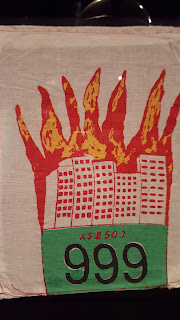....and so the 40 year anniversary of punk continues. Following the British Library's rather good look back at the genre and some of its key players we have the Museum of London's considerably slighter retrospective. The Museum of London is a wonderful and fascinating place and, considering how difficult it can to be to find on a first visit, can get surprisingly busy. Their advertising reach (probably due to lack of budget) sometimes doesn't make it out as far as me so I'd like to thank Jo for giving me the heads up on this show.
It tells the usual story of how the events of 1976 gave a voice to the disenfranchised but, instead of coming from the musicians, producers, and fanzine writers, through the voices, memories, and, most of all, clothes of the fans. The ones who were that at the time. So whilst the British Library exhibited Rat Scabies' leather jacket in a glass case here we get a Clash/Angelic Upstarts leather jacket in a glass case. Vive la difference!
To be fair there are more than enough stories, and artefacts, to justify the two shows. Testimonies of the fans include those of 13 year old Leeds schoolgirl Judi Atkinson who took to wearing chicken bones in her hair and Alberto Umbridge from Morden who sported the notorious 'tits' t-shirt and bondage trousers. Before that'd become part of the uniform of the postcard punk. Lesley Edgar would wear her customised t-shirt (below) with either fishnets or homemade plastic trousers.
There's a lovely little selection of lapel badges of the time. The Buzzcocks, Siouxsie, The Fall, ATV, The Lurkers, X Ray Spex, Spizz Oil, Penetration, and The Slits all represented. They've posters for punk gigs at the Coliseum and the Evening Standard piece about a riot at a '77 Clash concert at the Rainbow in Finsbury Park.
Zoe Neale's scrapbook from her punk days is notable for a few reasons. A Crass gig in Ealing and Rip, Rig, and Panic (Neneh Cherry's former outfit) at the ULU but mostly for the unlikely inclusion of Classix Nouveaux, Chicken Shack, and Slade!
There's a very small section devoted to the fanzine scene and Sniffin' Glue in particular. This was covered far better, and in more depth, at the British Library show. Of more interest are the recollections of the politicising effect of punk. Witness the homemade Crass t-shirt and the story of one Julian Shulman. He'd initially been put off punk by seeing The Sex Pistols wearing swastikas on television in their infamous interview with Bill Grundy. Rock Against Racism, a movement formed as a response to an increase in racial conflict and the growth of white nationalist groups such as the National Front, turned him round.
As it did many. The NF were actively looking to recruit at both football matches and at gigs. RAR was a movement that changed the political direction of untold numbers of youths. It was no longer acceptable to spout racist bullshit and though it took a generation for that to become mainstream political thought I truly believe some of the seeds were planted at that time. They certainly were for me.
That's what those ranting and raving about the ineffectiveness of the Women's March, and other demonstrations, on social media don't seem to get. This is a long game, a very long game, and by showing the next generation that kindness, fairness, and equality are better than hate, blame, and inequality we've got a chance of things starting to improve in the future. If not the next four years.
Not that the initial punks made any great claims about making things better. The No Future slogan is nihilism in its purest form. That kind of destructive behaviour, often paired with incredibly regressive music, was never going to last and soon more intelligent, musically adventurous, and downright political factions grew out of punk. Read Phil Hunt's quote below for an example of how lives were improved. Observe a young punk posing in front of a poster for Jamaican reggae deejay Prince Far I to see how the youth of Britain became open to more sonically adventurous music than before.
Amongst all this the young punks were, don't worry, still wearing daft clothes and doing silly things. Trevor Smith hung out in The Chelsea Potter on the King's Road (one of the few old punk hang outs still there, me and my friend Pam popped in for a drink after a Blondie exhibition once unaware of its history) and put toilet bleach in his hair.
Luke Blair's hand drawn cassette cases are probably more successfully creative than Trev's amateur coiffeuring. With The Damned and The Dead Kennedys next to The Birthday Party and Killing Joke they seem to come from a time when punk was transforming into new wave or goth.
Creative impulses continued, often at the expense of formal education. 14 year old Max Hamilton skipped school to make a hand printed 999 patch and Peter Compton, another schoolboy, heard John Peel playing punk on the radio and handmade the below City of the Dead t-shirt.
It may have been a small exhibition but it was an interesting one. It served as a complement to the larger British Library show rather than an alternative. I enjoyed hearing the tales of these young punks and how music, and dissemination of information and ideas, changed their lives. Although I'd say it's probably time to draw a line under punk nostalgia for a while now and focus on something else.
So counter-cultural and punk did I feel at the end of my afternoon in the Museum of London I had a cappuccino and a krispy cake with a Mini Egg on top. Fuck the system!















No comments:
Post a Comment